« Reviews
Behind the Wall
The 8th Floor - New York
Curated by Juan Delgado Calzadilla
By Jeff Edwards
A relentless spirit of ambivalence haunts the works in “Detrás del Muro (Behind the Wall),” the 8th Floor’s reincarnation of a 2012 Havana Biennial exhibition originally staged on the Malecón, a protective seawall and esplanade that has served as a gathering place for the city’s lovers, families, fishermen and lowlifes for more than a century. The 2012 show mounted a series of performances, installations and sculptures by 25 artists-22 of whom are represented here that explored the area’s legacy as both a hangout and a symbol of the mingled hopes and frustrations that loom large in the minds of many Cubans. The Malecón is an equivocal place: it’s undergoing a slow, bureaucratically hobbled process of urban renewal that’s scattered a handful of beautifully refurbished buildings into the midst of crumbling residential blocks and occasional mounds of rubble, and although the promenade’s view over Havana Bay whispers of freedom to some, it’s also a symbol of isolation and Cuba’s tricky relations with its invisible but burdensome neighbor to the north.
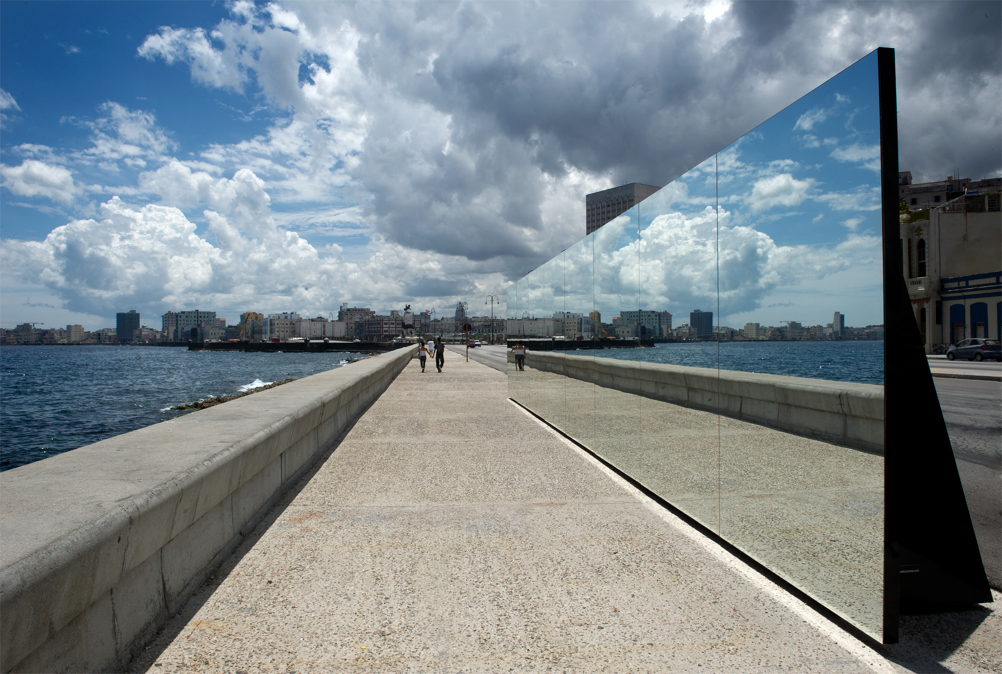
Rachel Valdés-Camejo, Felices para siempre (Happily Ever After), 2012, mirror plates, steel structure, gravel sacks, black acrylic plates, 52’ 5” x 9’ 84” x 3’ 28”. Installation view at the 11th Havana Biennial. Courtesy of the artist and Cuban Arts Projects.
A similar ambivalence murmurs from almost every wall in The 8th Floor’s revisitation of “Detrás del Muro.” A small but telling piece near the entrance is Carlos Montes de Oca’s print Conexión (Connection, 2013), a modified photo of Havana Harbor in which a ghostly set of airport landing lights juts into the water at dusk, pointing toward an inviting but eerily glowing sky that’s mostly obscured by dark clouds to the north. A dimly lit limb of the Havana skyline that intrudes into the far left has the same air of loneliness and desolation as the imaginary runway in the foreground. Conexión was never staged in Havana due to permit hassles from the institutions that control the Malecón, making its aura of thwarted desire and forced isolation all the more compelling. Several other projects presented here as mock-ups also met the same fate, such as Astigmatism (2013) by Jorge Wellesley, a scale model of an illuminated rooftop marquee overlapping the words “Verdad” (truth) and “Mentira” (falsehood) and melding them into a sinister pseudo-corporate logo looming over the city. (Although bureaucracy generally gets the blame for most of these failures, the word censorship has also come up fleetingly in a few of the artists’ less guarded moments.)
Other projects fared better during the biennial, such as a full-sized but strangely toylike DIY submarine built by Esterio Segura over the finned chassis of a vintage Cadillac. In the current show, the project is represented by Model CSXXI (2011), a 13-foot-wide white-on-black painted sketch that dominates an entire wall adjacent to de Oca’s Conexión, engaging in a silent but deeply captivating dialogue with it. Both incarnations of Segura’s piece echo hundreds of real-world attempts to flee to the United States by any means available (including actual car-to-boat conversions), but the version on display here has a more somber and romantic quality that’s missing in its three-dimensional counterpart. The comic-like depiction is so sleek and spy-novel sexy that it takes a few moments to notice a dozen or so faintly written call-outs that label the vehicle’s components; a closer look reveals that instead of technical designations, they’re poignant snippets of whispered longing: a large propeller jutting from the car’s trunk is tagged agobiados por la espera (”burdened by waiting”), while the right front tire carries the legend en el mar, oscuro mar (”in the sea, dark sea”). Yet although the captions’ gentle deflation of pulp novel escape fantasies is quietly tragic, there’s no sense of final defeat, just calm perseverance amid indefinite delay.
The seawall assumes a complex personality of its own in a few works that celebrate its impact on Havana’s social life. Humberto Díaz’s 20-minute drive-by video Déjà Vu (2008) casts the Malecón as the endlessly scrolling backdrop for a series of tiny human dramas that glide through the frame from left to right. Pureza (Purity, 2012) by Aimée García displays a folded black shawl that was woven on site to cover a long stretch of the wall; its allusion to traditional handmade couch covers highlights the Malecón’s importance as a shared social space, but the grid-like design visible in an adjacent mock-up image looks so much like a wrought iron fence that it’s impossible not to read the piece as yet another symbol of Cuba’s forced isolation.
Presenting these works in New York both enriches and distorts them by evoking the Unites States’ long history with Cuba and encouraging-for lack of a better English word-Norteamericano interpretations that can obscure what they signified to their original audience. A case in point is the sculpture Fly Away (2013) by Arlés del Rio, a small section of chain-link fencing with a gaping airplane-shaped hole punched through it. The broken fence wires are bent outward, a clear sign that it’s another piece about escape and the overcoming of obstacles, but at a first glance it can also be read as a protective barrier that’s been punctured from outside, a potent reminder of a long history of real and abortive U.S. invasions that goes back to 1901, when the Malecón was built during a period of American occupation and military rule.
This tangled history has another, much thornier implication: art’s exemption from of the broad trade embargo that has kept Cuba so culturally isolated for so long is a major reason why these works are available for display in New York, and perhaps also why they look so slick and polished, equal in quality to anything else fabricated for the world’s intricate web of galleries, museums and art fairs. There’s a serious elephant-in-the-room irony to the fact that many of these works about isolation have so clearly benefited from the artists’ contacts with the wider realm of global art making and international patronage. This can’t be ignored, but there’s an uncomfortable hint of condescension latent in citing it: using art-market slickness as a standard for judgment carries the snide implication that this work wouldn’t (or perhaps couldn’t) exist without the help of Cuba’s neighbors to the north and elsewhere.
A few works in the show don’t create nearly as strong an impression as their Malecón counterparts, due to logistics and differences in scale or purpose. Rafael Domenech’s model for Possible Chances (2012) lays out a Lilliputian cluster of open doors that lead everywhere and nowhere; while its life-sized cousin in Havana served as a fanciful free-play zone for thousands of momentary acts of self-determination, the tiny prototype looks too much like a fragile dollhouse miniature to have nearly the same impact. Other pieces seem to handle the reduction in scale and the change in location with a much more potent sense of irony, whether intentional or not. Florencio Gelabert’s Island (2013) replaces a large, colorful floating sculpture cobbled together from Havana Bay flotsam with a much smaller assemblage made from a broken chair and picture frame painted a neutral gray. The basic symbolism is the same-shattered domestic goods are granted new life as quasi-nostalgic cyphers of the past-but the replacement of the biennial’s fanciful, bobbing toy island with a pedestal-bound fine-art object nullifies a lot of the original piece’s playfulness and thwarts the resulting desire to gather around and invent stories about the past lives of its component parts.
A similar but much more interesting diminution has happened to Rachel Valdés-Camejo’s Happily Ever After (2012), which in Havana took the form of an enormous sea-facing mirror that veiled the city behind an endless prospect of sky and water, hiding some of the more unsightly by-products of its sluggish, rubble-strewn process of renovation. Its 8th Floor surrogates have a much more sardonic feel: an installation photo shows the Havana skyline intruding into the reflection and partially tainting the grand illusion of infinite space, while a small presentation model of the project freezes a small, matte-black everyman figurine in front of the much more constricted reflection of the gallery space and its postmortem collection of static biennial relics.
One of the most striking and incisive comments on the Malecón’s ongoing facelift is found in Adonis Flores’s Fe II (2013), a large chromogenic print documenting a junk sculpture suspended in front of a sadly run-down building. The scaffold-bound wreckage forms the word “Fe”-the chemical symbol for iron, but also the word “faith,” and perhaps even a pun on fue (”it was”)-out of rusty flattened car parts, corrugated metal roof sheets, and misshapen 55-gallon drum lids. It’s hopelessly inadequate as a screen for the ugly hulk behind it, but as a vision of hope for rebirth from the rubble it’s improbably, naggingly beautiful. The bright façade of a freshly renovated building next door reinforces the message and contradicts it at the same time. Like so much else in the show, it’s an eloquently multifaceted portrait of Havana’s past and present, as well as its sometimes-hazy but never abandoned dreams for the future.
(September 26, 2013 - January 23, 2014)
Jeff Edwards is an arts writer and faculty member in the Visual and Critical Studies program at the School of Visual Arts (SVA) in New York. He has an M.F.A. in Art Criticism and Writing from SVA and a master’s degree in Public and Private Management from the Yale School of Management.
Filed Under: Reviews

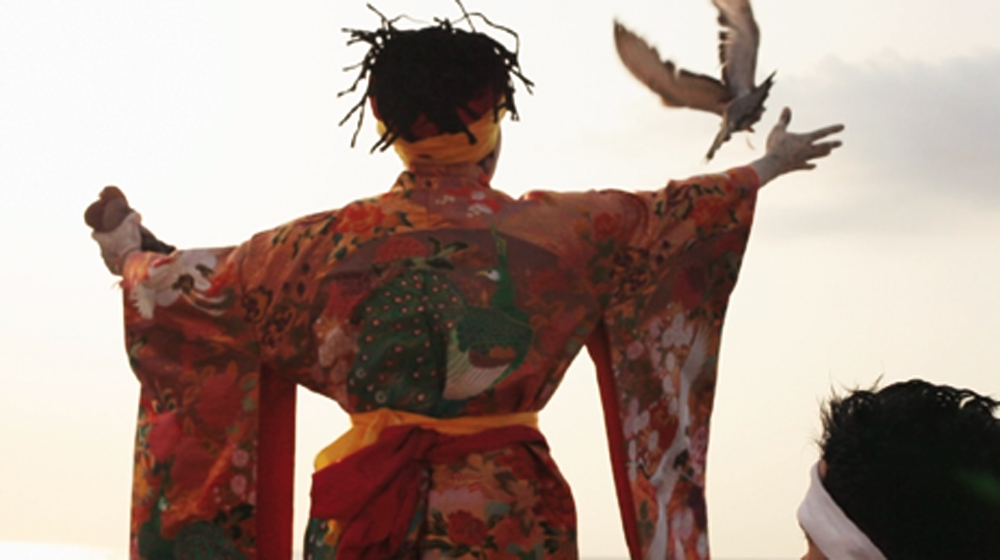
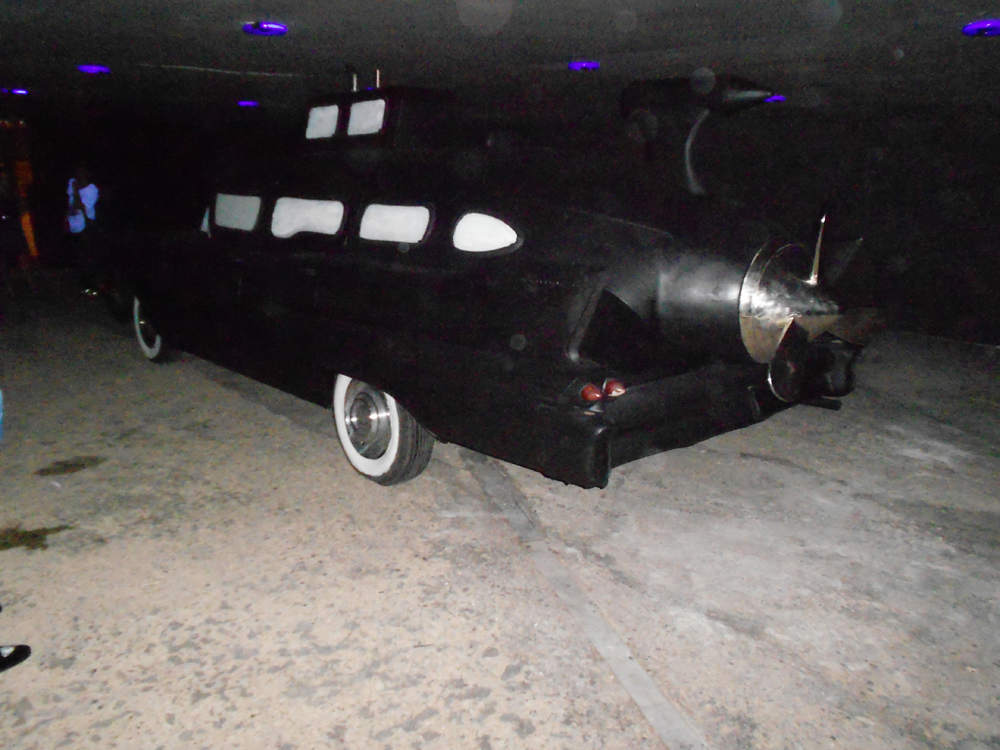
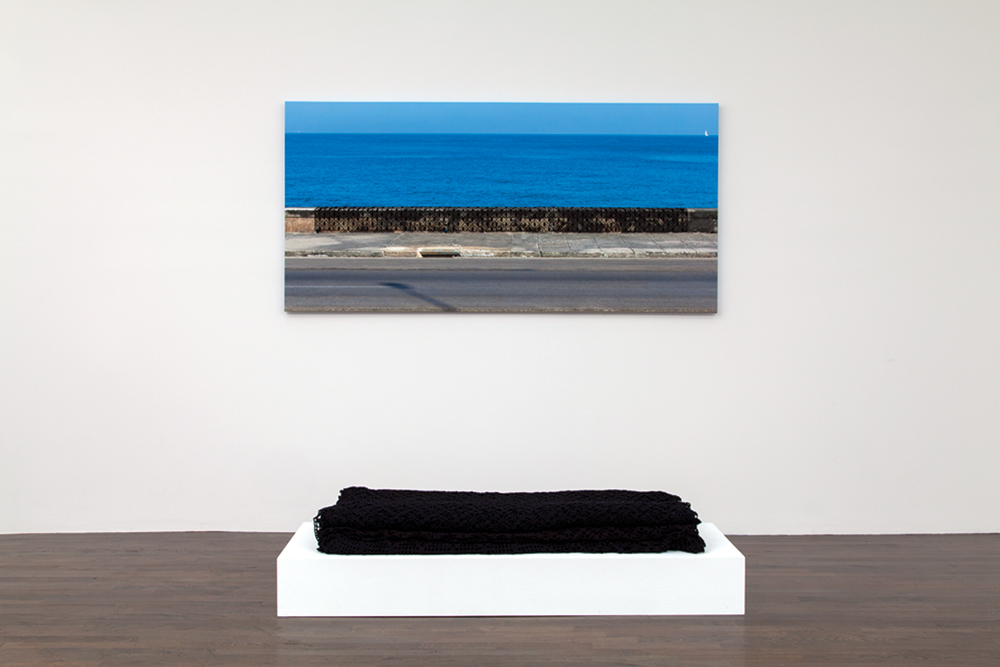
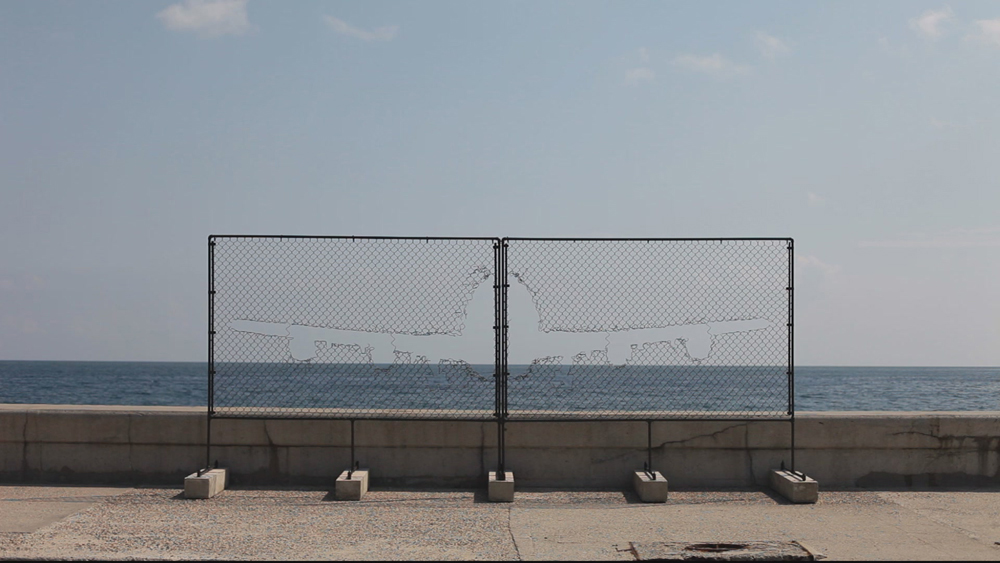





































Leave a Reply
You must be logged in to post a comment.